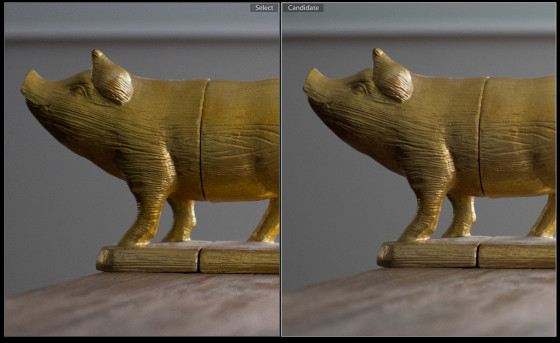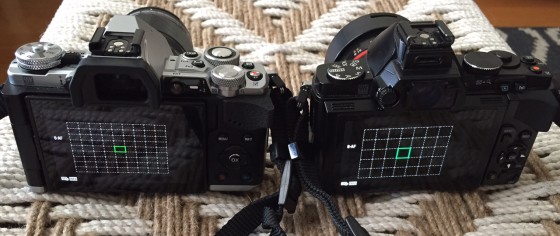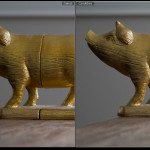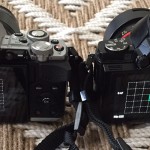
OMD EM5 MkII Review + Comparison with the Original OMD EM5
I’ll start off by saying that the OM-D E-M5 mkII is a great camera, like it’s predecessor. It’s small, fast, light, got a great sensor, and it has a huge ecosystem of high quality lenses to back it up. The Micro Four Thirds system as a whole is a great option for those who want a small camera that can hang with the big boys, without all of that weight to lug around.
I’ve had the OM-D E-M5 mkII for more a month and a half now, and I’ve taken more than 5000 shots with it so far. I’ve also owned the original OMD EM5 for 2.5 years (see my original review here), so this post will be a review of the OM-D E-M5 when compared to the classic OMD EM5 (which is about half the price) – along with example photos from the mkII.
Let’s cut to the chase and compare the OMD EM5 mkII vs the OMD EM5 mkI:

Things I like about the OM-D E-M5 mkII vs the original
- EVF is great (much better, bigger and more lifelike – with better resolution & clarity)
- new in body stabilization is rock solid and great for video or stills
- rear LCD resolution and color are better
- new swivel flash is awesome
- focus peaking is great to have
- autofocus feels more accurate, especially with faces
- Wi-Fi is a godsend if you want to post photos quickly (no PC needed!)
- ergonomics are better, the new camera is easier to hold
- camera is more responsive / faster
- flip screen is great for selfies or photo booths
- silent mode shooting is really good for non flash photography
- high resolution mode gives you 40MP files
- tons of video options (frame rates, sizes, tracking modes)
- a lot more buttons (lots of customization options)
Things I DON’T like about the OM-D E-M5 mkII vs the original
- image quality didn’t really improve much, if at all
- flip screen a little hard to get used to
- much easier to press the record button easily (lots of accidental video)
- flip screen is harder to use for discrete photography and takes longer to tilt up
- flip screen easily blocked by cables / ports
- weather sealing is not as good as they say
- sometimes flash triggers don’t sync properly after the camera goes to sleep
- high resolution mode requires a tripod
- a lot more buttons (can get confusing)

It’s undeniable that the OMD EM5 mkII is a superior camera to the mkI, but is it worth $500 more? If image quality is all you are concerned with, then you aren’t going to see that much of an improvement. Maybe there is more dynamic range and the colors render a little better, but overall the sensor seems to be the same. If you trust DXO Mark, the mkII got a score of 73 and the mkI got a 71. Nothing earth shattering here – the sensor is pretty much the same.
In this photo, the OMD EM5 mkII sample is on the left, and the mkI sample is on the right (both zoomed in to 50% at ISO 800).
In terms of being a better camera usability wise, the newer camera definitely feels faster. The OMD EM5 mkII has 81 focus points vs the 35 focus points of the original camera, and the AF seems to lock on a little better on the new model too. I feel a little more confident that focus will lock than I did before, especially when photographing people.
Below is a non scientific demo I made showing the focus speed differences between the two models (using the same lens). While the actual focus time seems the same, the recovery time before you can take another shot seems a bit faster and more responsive to my touchscreen input on the mkII (I was using the same SD card for both tests as well).
Side note – I’m actually on my second OMD EM5 mkII. I took mine out in a light rain with a water sealed Olympus 60mm macro lens, and the camera failed. Olympus support was super helpful, sending me a replacement ASAP (in time for my 2.5 week trip to Asia), but I’m wary of getting water on my camera in spite of the fact that in Olympus ads, large volumes of water are splashed on the camera. I’m interested in hearing other peoples’ experiences with the taking camera out in the rain… but I wouldn’t try it at home if I were you.
What are the killer new features on the OM-D E-M5?
For me, the three most important upgrades are:
New viewfinder / EVF – for you Apple fans out there, remember the jump from the iPhone 3GS screen to the one on the iPhone4? Or for you Canon fans out there, remember how much better the LCD the screen was on the 5DmkIII than on the 5DmkII? Both screen upgrades made using the new devices much more pleasurable, with better color reproduction and a feeling of realism that made the older version feel a little toy-like.
That’s how the change in resolution on the new OMD’s screens feels. Higher resolution in the EVF allows you to truly see what a photo is going to look like before you take the photo and that level of realism narrows the gap between SLRs and mirrorless cameras. Looking through the original EM5’s viewfinder now feels like you are looking at a mediocre, low resolution reproduction of the scene (sometimes with jaggy edges), but when looking through EM5mkII’s EVF, you feel like you are looking at what the actual photo will look like in real time. And perhaps most importantly, you can truly tell if your subject is in critical focus, or if it’s just sort of close (especially now that focus peaking is an option).
Wi-Fi – I didn’t expect to love having Wi-Fi on the camera as much as I do. Sure, it’s just a single (some say gimmicky) feature, but it gives you a lot of freedom, especially if you like to travel light. Having Wi-Fi negates the need to carry around a laptop for me, which is a big deal if you are on a long trip. Half of the reason I love m43 is for the light weight of the system, and if I can carry 5 pounds less on my trip because I left the laptop at home, that’s even better. Wi-Fi also negates the need to have a separate release trigger, which will save you some money and space in your camera bag as well.
Also, now that awesome photo editing apps like Snapseed are available on your phone and the in camera RAW converter in the EM5mkII produces great results for web use, you can post your images online within minutes of taking them, no matter where you are. On this trip, no longer was I frustrated by slowly transferring gigs of files to a laptop, then having to worry about installing special software to convert RAW images, obtaining separate licenses for editing software on my desktop vs laptop, or finding Wi-Fi… I just pick the one file I want, convert to JPG, then upload to my phone to edit or upload to the social network of my choice. The old process took hours and caused much frustration… the new one just takes minutes.
Side note: If you travel internationally often and you live in the US… T-mobile’s free international data roaming is amazing. It’s 3G only while you are abroad, but it’s more than adequate for uploading to Flickr or Instagram.
Better Stabilizer – The in body sensor based stabilizer on the OM-D E-M5 mkII is supposedly 1 stop better than the one on the original OM-D E-M5’s, which was already awesome. One stop isn’t a big deal… right? Well, it kind of is. With the old OMD, I could shoot a photo at 1/20th or so and I could feel halfway confident that it would come out. Now, I don’t even have to worry at all.
But stills aren’t where the stabilizer shines. While I don’t use this feature that often, the new and improved stabilization system is also amazing for video. Handheld footage looks like it was shot on a very stable tripod if you just want a static camera, and you can do some pretty impressive pans and tilts without any additional gear. The 5 axis stabilizer on the OM-D E-M5 mkII takes some amazing smooth video considering… the original mkI, not so much.
I’m not much of a cinematographer, so don’t expect too much out of these videos… but they both show how stable footage out of the camera can look when using lenses with a long focal length, handheld.
Now the big question: Should you buy the OMD EM5 mkII?
My recommendation: If you have the money, just do it! This is a great camera with lots of great features. If you are already bought into the Micro 43rds system and have an older camera, this is a worthy upgrade.
If you don’t have the money, and you have a fairly recent m43 camera, maybe you can wait a while. The image quality is pretty much the same as the OMD EM5 mkI, so if you already have one of those and you don’t have a need for video, Wi-Fi, or a better EVF… if you wait 6 months you can probably get the camera for a few hundred bucks cheaper. Just don’t try to use any of your friends’ OMD EM5 mkIIs tough, because you will get jealous and want to upgrade :)
If you want to get into m43 for the first time… that’s a different decision altogether. Micro Four Thirds’ main advantage is that you can get some amazing lenses for relatively cheap that produce images that are excellent. Also, you can fit an entire camera system into a small bag the size of a school lunchbox – which can’t be said for any of the DSLR cameras or even the APS-C sized sensor mirrorless cameras. For the most people, m43 will provide the image quality you need, unless you need a lot of bokeh / background blur or if you are one of those people that needs the absolute best image quality (and doesn’t mind carrying around a 5lb camera).
TLDR; version – it’s a great camera that improves on the original in a lot of ways.
If you want to check out more photos from the OMD EM5 mkII, check out the gallery below. And if you want to buy this camera, please click on my links to Amazon below!























VanJan -
Great and to the point reviev from the users point of view. :-)
Thanks for the detailed pros and cons list. Makes my decision a lot easier.
Immanuel -
This is honestly such a well done review that entertains photographers from beginner to enthusiast without getting down to the spec sheet (which I find redundant and boring altogether). So bravo to you!
Also, I have a question. I just recently let my a6000 go as I was able to sell it and make a profit due to the craze behind that camera. Another reason why I sold it was the lens selection and price. It’s absolutely difficult to grab an inexpensive glass that takes good-great photos especially here in Canada. I’d have to order everything online which is subject to taxes and duties. I’ve been looking at this as a replacement but a buddy of mine has been pushing me towards the dslr market instead. I’m not a professional photographer but I do want to broaden and better my understanding and skills, so I was hoping to grab another camera I’m able to grow with.
Would this be the best fit?
Zach -
I like your brief comparison between these two cameras. However, I am in the boat of buying a m4/3 camera for the first time and I’m torn between getting the EM-5 or the EM-5 mark ii. You started to address this decision at the end but never gave your recommendation on what to do. The original can be had with the kit lens for around $400 which is a steal. However I do think that the better EVF would be a big selling point for me because I’m use to a canon full frame DSLR. What would you do if you were in my shoes? Spend $1000 plus the money on a couple lenses for the mark 2 or get the original and have some more money towards nicer lenses? I’m wanting to use it as a backup or a lightweight travel system.
Peter -
@Immanuel – I think the OMD EM5 mkII is a great alternative to a DSLR for learning. You still have the same manual control over aperture, shutter speed, white balance, ISO, etc that you would with a DSLR, and the live preview probably makes it easier to understand photography concepts if you are just learning. I also think for a casual user, you would be more likely to carry around something lighter than a bigger camera.
@Zach – I took some great pictures with the original EM-5. The viewfinder is really useful in bright light, or in situations where you want to stabilize the camera against your head. Other than those situations, you can probably make do with the LCD on the back of the camera. If money is a concern, maybe go with the older version and a couple of nice lenses.
I’m used to the Canon full frame system too, but often I actually like using the rear LCD better than looking through a viewfinder. You get a more a true representation of what the image will look like once the photo is taken.
You might miss some of the bokeh you got with full frame, so it might be good to buy a couple of bright primes with your remaining $600. The 17mm 1.8 and the 45mm 1.8 would fit the bill for that budget… or maybe the 25mm 1.8 – all of them are great lenses.
Rebekah -
Greetings! Now that you are over a year since you posted this review, would you still recommend the upgrade? I have both the EM5i and EM5ii sitting in front of me. I’ve LOVED me EM5 for over two years and just purchased the II a couple weeks ago to try out. I still have a few days to return it, and I just can NOT seem to make a decision. Your comment about having it fail in the rain makes me nervous, as I’ve had mine out many times with no issue. I’m also worried about the LCD screen issues people have been having – with it failing to work for long, or falling off. I agree, it’s hard to get used to. Convenient some of the time and then kind of obnoxious for the rest of the time. I LOVE the speed of it, the new EVF, and better screen resolution and the extra buttons to set –
So, after owning it for a over a year, how do you feel now? What would you recommend? Keep it or take it back and continue to enjoy my EM5i?
Side note: I will be giving my original EM5 to my sister-in-law if I keep the II. If I don’t, I will purchase a EM5 for her.
Mate -
Thanks for this really useful review!
It has by far the best and most natural sample images of all the reviews I’ve seen so far. Can you tell me about how you made them? Are they customised OOC jpgs or developed raws? I’m wondering if you can get natural looking jpgs like your samples out of the E-M5 II possibly without using the HDR mode.
Peter -
After owning the EM5 for a year, I feel that it’s perhaps my favorite camera. I still use it almost every week and I really love the 12-40 2.8 lens, which I keep on the camera most of the time, switching to primes when I have a special need.
I did give my original OMD EM5 to my dad, and while he likes it, I find the ergonomics on the mkII to be much better. The buttons on the back of the original EM5 seem a bit cramped to me now when I pick his up. I also love the LIVE COMP mode on the EM5 mkII, which is useful for capturing star trails. I’ve found Wi-Fi to be the most convenient feature of all, as I like to post photos to Instagram when I travel, and it’s far more convenient to upload photos from the camera to a phone than to have to lug around a laptop.
In general I think the mkII is a better camera and I would go with that now that prices have fallen. Really it depends on your budget though, and if you don’t think you need the new functionality, the original EM5 is still a great camera.
Shawn -
Nice comparison review. I’ve had the E-M5 for 3 years, and the E-M5ii for about 6 months now. The EVF is much nicer on the mark ii, although I find the colours less accurate, especially blue skies. The original E-M5 weather sealing is excellent, and I have drenched mine in pouring rain, snow, hail and blowing desert sand many times. I have not yet tested the mark ii in all of these conditions, but it has been wet several times, and I’ve rinsed it off to remove fine beach sand also. I am curious where yours failed. The mark ii certainly has more entry points for water/dust, and making sure the port covers are secure is a must – my flash sync port cover came off in the bag once, which is something to watch for. I don’t know if this port is sealed without the screw in cap or not.